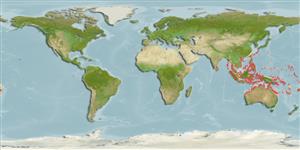>
Gobiiformes (Gobies) >
Gobiidae (Gobies) > Gobiinae
Etymology: Ctenogobiops: Greek, kteis, ktenos = comb + Latin, gobius = gudgeon + Greek, ops = appearance (Ref. 45335).
Environment: milieu / climate zone / profondeur / distribution range
Écologie
marin récifal; profondeur 0 - 15 m (Ref. 48637). Tropical; 30°N - 24°S
Western Pacific: Ryukyu Islands to Queensland, Australia, east to Mariana Islands. Eastern Indian Ocean: Andaman Sea and northwest Australia (Ref. 9710); including China (Ref. 31517).
Taille / Poids / Âge
Maturité: Lm ? range ? - ? cm
Max length : 8.0 cm SL mâle / non sexé; (Ref. 48637)
Description synthétique
Clés d'identification | Morphologie | Morphométrie
Épines dorsales (Total) : 7; Rayons mous dorsaux (Total) : 11 - 12; Épines anales: 1; Rayons mous anaux: 11 - 12. Characterized by pale grey body color; side of body with four longitudinal rows of dark brown spots (midlateral row largest); presence of small ocellated yellow to orange spot between each pair of midlateral brown spot; head and body covered with scattered small yellow to brown spots; basal part of pectoral fin with intense white spot; longitudinal scale series 50-55; opening of gill extending to or slightly before vertical at posterior edge of preopercle; greatest depth of body 4.5-5.0 in SL; rounded caudal fin, about equal to head length (Ref. 90102).
Body shape (shape guide): elongated; Cross section: circular.
Occurs on fine sand and silt bottoms of subtidal reef flats and lagoons to a depth over 20 m. Uses burrows of alpheid shrimps for refuge. Inhabits coastal sand slopes to about 15 meters depth (Ref. 48637).
Life cycle and mating behavior
Maturité | Reproduction | Frai | Œufs | Fécondité | Larves
Myers, R.F., 1991. Micronesian reef fishes. Second Ed. Coral Graphics, Barrigada, Guam. 298 p. (Ref. 1602)
Statut dans la liste rouge de l'IUCN (Ref. 130435: Version 2025-1)
Menace pour l'homme
Harmless
Utilisations par l'homme
Pêcheries: commercial; Aquarium: Commercial
Outils
Articles particuliers
Télécharger en XML
Sources Internet
Estimates based on models
Preferred temperature (Réf.
123201): 25.3 - 29.3, mean 28.7 °C (based on 2383 cells).
Phylogenetic diversity index (Réf.
82804): PD
50 = 0.5020 [Uniqueness, from 0.5 = low to 2.0 = high].
Bayesian length-weight: a=0.00724 (0.00339 - 0.01546), b=3.10 (2.92 - 3.28), in cm total length, based on LWR estimates for this (Sub)family-body shape (Ref.
93245).
Niveau trophique (Réf.
69278): 3.3 ±0.40 se; based on food items.
Résilience (Réf.
120179): Haut, temps minimum de doublement de population inférieur à 15 mois (Preliminary K or Fecundity.).
Fishing Vulnerability (Ref.
59153): Low vulnerability (10 of 100).
🛈
Nutrients (Ref.
124155): Calcium = 159 [71, 319] mg/100g; Iron = 0.798 [0.411, 1.557] mg/100g; Protein = 18 [16, 20] %; Omega3 = 0.0919 [, ] g/100g; Selenium = 20.8 [9.2, 48.3] μg/100g; VitaminA = 147 [39, 516] μg/100g; Zinc = 2.14 [1.36, 3.22] mg/100g (wet weight);
